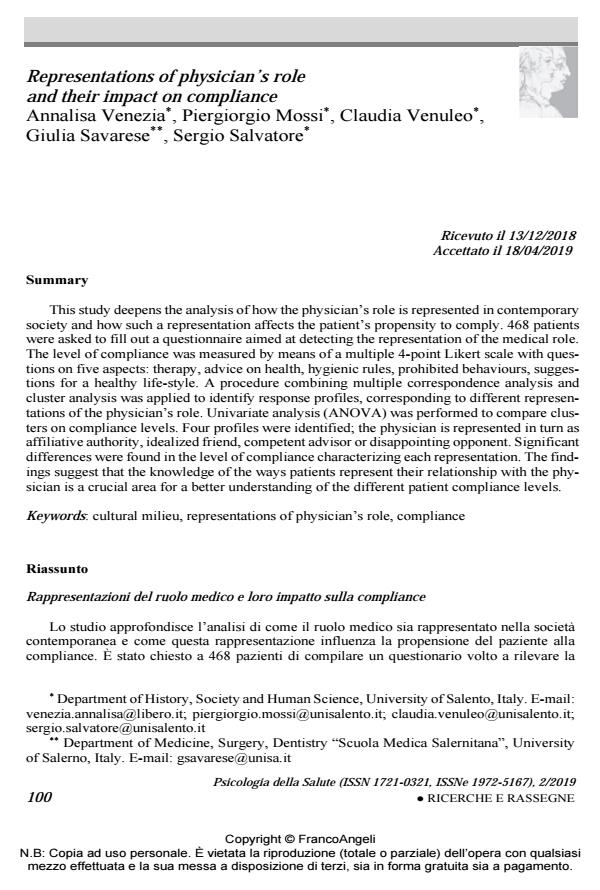Representations of physician’s role and their impact on compliance
Titolo Rivista PSICOLOGIA DELLA SALUTE
Autori/Curatori Annalisa Venezia, Piergiorgio Mossi, Claudia Venuleo, Giulia Savarese, Sergio Salvatore
Anno di pubblicazione 2019 Fascicolo 2019/2
Lingua Inglese Numero pagine 22 P. 100-121 Dimensione file 294 KB
DOI 10.3280/PDS2019-002005
Il DOI è il codice a barre della proprietà intellettuale: per saperne di più
clicca qui
Qui sotto puoi vedere in anteprima la prima pagina di questo articolo.
Se questo articolo ti interessa, lo puoi acquistare (e scaricare in formato pdf) seguendo le facili indicazioni per acquistare il download credit. Acquista Download Credits per scaricare questo Articolo in formato PDF

FrancoAngeli è membro della Publishers International Linking Association, Inc (PILA)associazione indipendente e non profit per facilitare (attraverso i servizi tecnologici implementati da CrossRef.org) l’accesso degli studiosi ai contenuti digitali nelle pubblicazioni professionali e scientifiche
This study deepens the analysis of how the physician’s role is represented in contemporary society and how such a representation affects the patient’s propensity to comply. 468 patients were asked to fill out a questionnaire aimed at detecting the representation of the medical role. The level of compliance was measured by means of a multiple 4-point Likert scale with ques-tions on five aspects: therapy, advice on health, hygienic rules, prohibited behaviours, sugges-tions for a healthy life-style. A procedure combining multiple correspondence analysis and cluster analysis was applied to identify response profiles, corresponding to different represen-tations of the physician’s role. Univariate analysis (ANOVA) was performed to compare clus-ters on compliance levels. Four profiles were identified; the physician is represented in turn as affiliative authority, idealized friend, competent advisor or disappointing opponent. Significant differences were found in the level of compliance characterizing each representation. The find-ings suggest that the knowledge of the ways patients represent their relationship with the phy-sician is a crucial area for a better understanding of the different patient compliance levels.
Lo studio approfondisce l’analisi di come il ruolo medico sia rappresentato nella società contemporanea e come questa rappresentazione influenza la propensione del paziente alla com-pliance. È stato chiesto a 468 pazienti di compilare un questionario volto a rilevare la rappre-sentazione del ruolo del medico. Il livello di compliance è stato misurato tramite una scala Li-kert a 4 punti con domande relative a cinque aspetti: terapia, consigli sulla salute, norme igieni-che, comportamenti vietati, raccomandazioni per uno stile di vita salutare. Una procedura com-binata di analisi delle corrispondenze multiple e analisi dei clusters ha consentito di identificare differenti profili di risposta, corrispondenti a differenti rappresentazioni del ruolo medico. Per confrontare i clusters sui livelli di compliance è stata applicata un’analisi della varianza (ANOVA). Sono stati identificati quattro profili: il medico è rappresentato in termini di autori-tà affiliativa, amico idealizzato, consulente competente o spiacevole avversario. Differenze si-gnificative sono state riscontrate nei livelli di compliance caratterizzanti le diverse rappresenta-zioni. I risultati suggeriscono che la conoscenza dei modi con cui i pazienti rappresentano la loro relazione con il medico è fondamentale per una migliore comprensione dei loro differenti livelli di compliance.
Parole chiave:Milieu culturale, rappresentazioni del ruolo medico, compliance
- Foundation of Ethics-Based Practices Raffaele De Luca Picione, Maria Francesca Freda, Livia Savarese, pp.115 (ISBN:978-3-030-83665-8)
- Methods and Instruments in the Study of Meaning-Making Claudia Venuleo, Tiziana Marinaci, Giulia Savarese, Annalisa Venezia, pp.169 (ISBN:978-3-031-21994-8)
- The Meaning of Living in the Time of COVID-19. A Large Sample Narrative Inquiry Claudia Venuleo, Tiziana Marinaci, Alessandro Gennaro, Arianna Palmieri, in Frontiers in Psychology 577077/2020
DOI: 10.3389/fpsyg.2020.577077 - Methods and Instruments in the Study of Meaning-Making Sergio Salvatore, Raffaele De Luca Picione, pp.3 (ISBN:978-3-031-21994-8)
- The Search for Origins by the Adopted Children: The Perspective of Adoptive Mothers in the Italian Context Barbara Cordella, Rossini Susanna, Paola Elia, Matteo Reho, Alessandro Gennaro, in Adoption Quarterly /2024 pp.191
DOI: 10.1080/10926755.2023.2172507 - Caregivers’ Sensemaking of Children’s Hereditary Angioedema: A Semiotic Narrative Analysis of the Sense of Grip on the Disease Maria Francesca Freda, Livia Savarese, Pasquale Dolce, Raffaele De Luca Picione, in Frontiers in Psychology 2609/2019
DOI: 10.3389/fpsyg.2019.02609 - Making sense of the COVID-19 pandemic: A qualitative longitudinal study investigating the first and second wave in Italy Tiziana Marinaci, Claudia Venuleo, Alessandro Gennaro, Gordon Sammut, in Heliyon e07891/2021 pp.e07891
DOI: 10.1016/j.heliyon.2021.e07891
Annalisa Venezia, Piergiorgio Mossi, Claudia Venuleo, Giulia Savarese, Sergio Salvatore, Representations of physician’s role and their impact on compliance in "PSICOLOGIA DELLA SALUTE" 2/2019, pp 100-121, DOI: 10.3280/PDS2019-002005